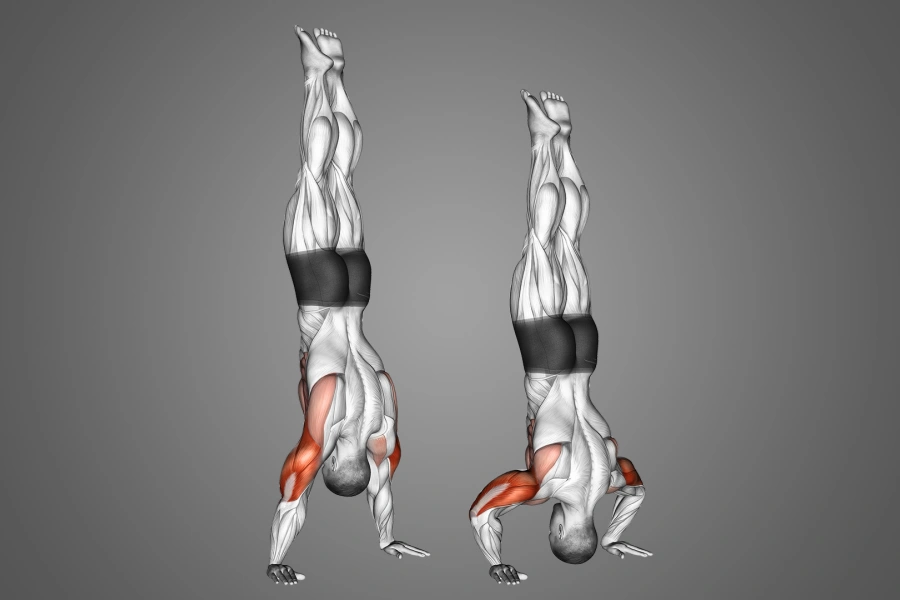Hey there, fellow fitness enthusiast! So, you’re eyeing that impressive handstand push-up (HSPU), huh? Maybe you’ve seen videos, or someone at the gym makes it look effortless. But when you kick up against the wall, it feels like trying to lift a car with your shoulders? Trust me, I get it. I remember my first attempts vividly – shaky arms, a nervous wobble, and maybe a very ungraceful descent or two. The truth is, the HSPU demands serious shoulder strength, stability, and body control that most beginners (myself included back then!) simply haven’t built yet. Jumping straight into it is like trying to run before you can crawl. That’s why we need smart handstand push up alternative for beginners – stepping stones to build you up safely and effectively. Let’s break down what we’re really training for and then dive into the exercises that will get you there.
Handstand Push Ups Muscles Worked
Before we jump into the alternatives, let’s quickly meet the muscle squad doing the heavy lifting in a proper HSPU. Understanding this helps you feel the right muscles working in the substitutes:
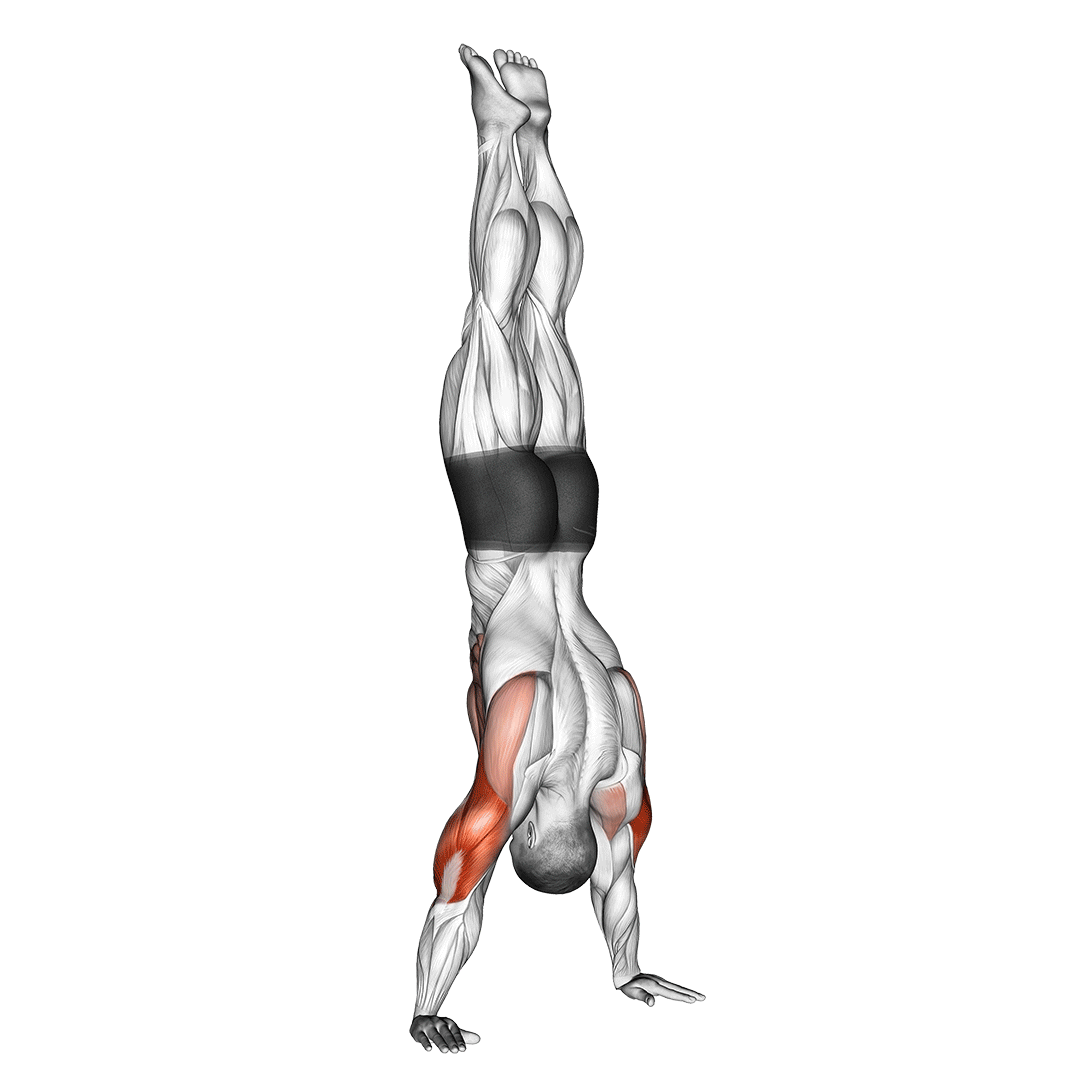
Shoulders (Deltoids):
These are the caps on top of your arms. Think of them as your primary overhead press engine. – the deltoids, especially the front (anterior) and side (lateral) heads, are the MVPs for generating the upward force. They work tirelessly throughout the entire movement.
- Function: They lift your arms straight up overhead (like pressing dumbbells) and control the lowering phase.
Pectoralis Major: Your main chest muscle.
- Function: While primarily a horizontal presser (like a bench press), it provides crucial stability and assists in the pressing motion during a HSPU, especially in the bottom position.
Triceps Brachii: The muscle running along the back of your upper arm.
- Function: These guys are the elbow straighteners! They lock out your arms at the top of the press and control the bend during the descent. Absolutely critical for the final push.
Trapezius (Upper/Middle): Those large muscles across your upper back and neck.
- Function: They stabilize your shoulder blades, pulling them down and together (“packing” the shoulders). This creates a solid base for pressing overhead and prevents your shoulders from collapsing towards your ears.
Okay, team introduced! Now, let’s build up that team strength with exercises you can conquer right now.
7 Exercises For Beginners Handstand Push up Alternative
Forget kicking up against the wall just yet. These exercises will systematically build the strength, stability, and confidence you need. I’ve used these countless times with clients (and myself!) to bridge that gap. Let’s walk through them together:
Dumbbell Z Press
Hits those shoulders (deltoids) and triceps hard, while forcing incredible core stability and upper back (trapezius) engagement to keep you upright. It eliminates leg drive, isolating your pressing power – exactly what you need for the strict HSPU strength. It also teaches you to maintain that crucial tight torso position.
When I first did these, I realized how much my legs were cheating on my standing presses! The Z Press humbled me and showed me my true shoulder strength (or lack thereof!). It’s a game-changer for building that raw pressing power safely.
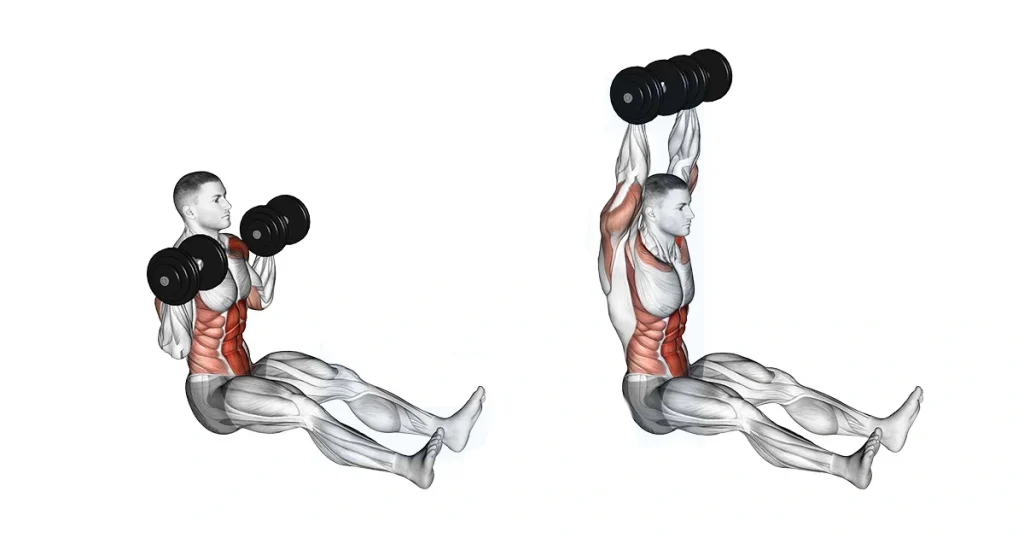
- How to Do It Right:
- Sit on the floor with legs straight out in front (like a “Z”).
- Hold dumbbells at shoulder height, palms facing each other or slightly forward.
- Brace your core HARD – imagine someone is about to poke you in the stomach.
- Pull your shoulder blades down and back (“pack” them).
- Press the dumbbells straight overhead until arms are fully locked out. Focus on driving straight up, not forward.
- Slowly lower back to shoulder height with control. That lowering part? Crucial for HSPU strength! Fight gravity.
- Pro Tip: Start LIGHT. Focus on perfect form and feeling your shoulders and core work. Don’t let your lower back arch!
Seated Dumbbell Press
Primarily targets the shoulders (deltoids) and triceps, with secondary help from the upper traps for stability. Sitting removes leg drive and lower back involvement, forcing your shoulders to do the honest work. It’s fantastic for building pure pressing strength through a full range of motion.
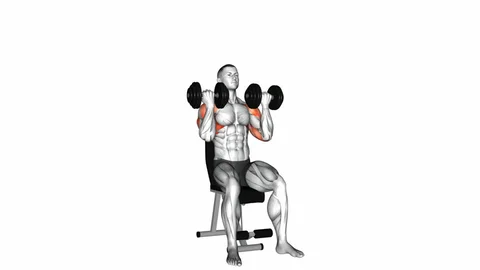
- How to Do It Right:
- Sit tall on a bench (back support optional, no support is harder on core).
- Hold dumbbells at shoulder height, elbows slightly in front of the body, palms facing forward.
- Brace core, pack shoulders.
- Press the dumbbells straight up until they nearly touch at the top, arms fully extended.
- Slowly lower back down with control. Focus on feeling the shoulder muscles contract and stretch.
Pike Pushups
This is your gateway inversion! Hits the shoulders (deltoids), triceps, and upper chest (pectorals) while requiring core strength to hold the pike position. It mimics the HSPU angle much more closely than floor presses. Scalability: Elevate your feet on a sturdy box/step to increase difficulty as you get stronger.
I had a client who couldn’t do a single pike pushup without collapsing. We started with her feet low and hands elevated slightly on books. Within weeks? Full pike pushups on the floor! That foundational strength translated directly.
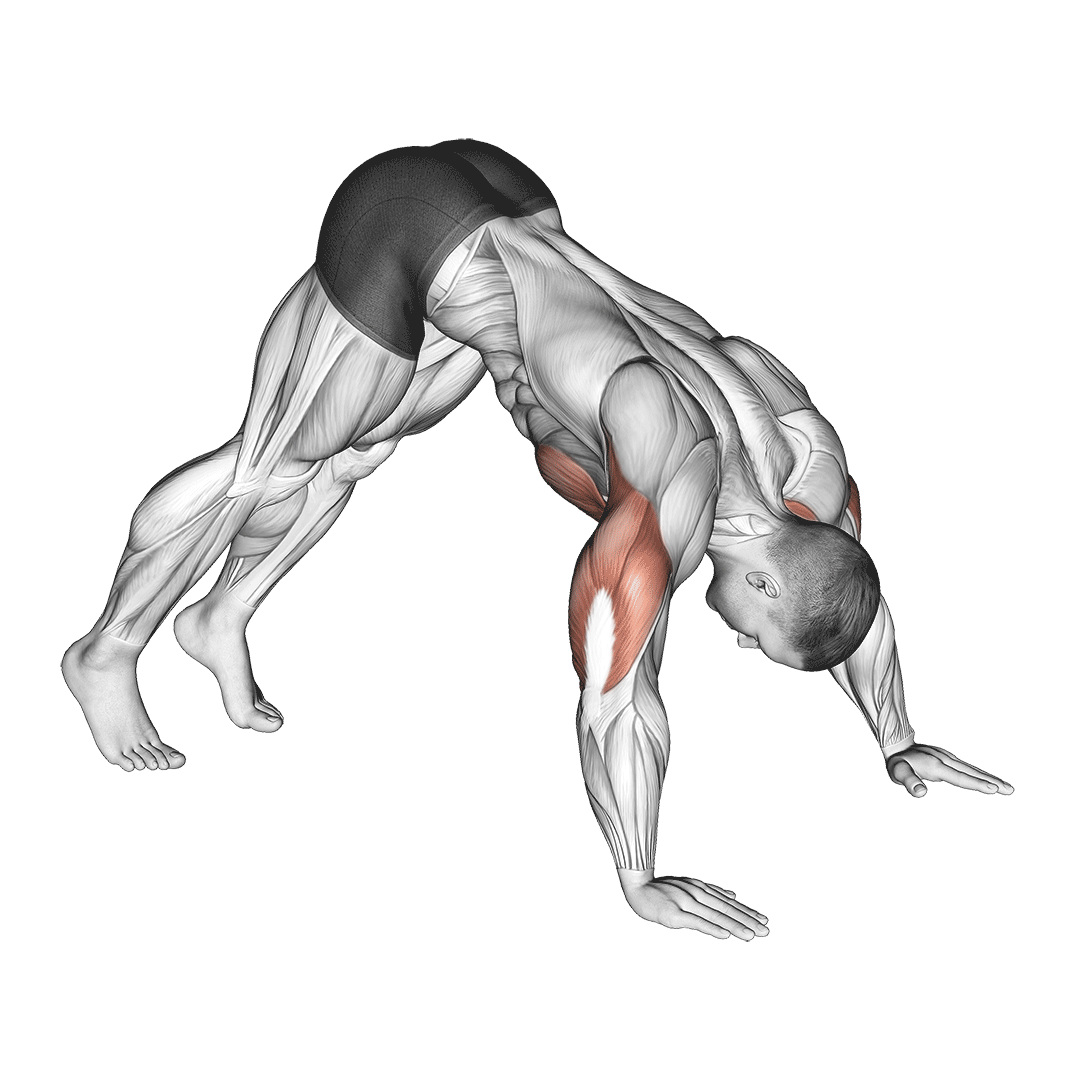
- How to Do It Right:
- Start in a Downward Dog yoga pose: Hands shoulder-width apart, feet hip-width apart, hips pushed high towards the ceiling, forming an inverted “V”. Aim to get your hips directly over your shoulders as much as flexibility allows.
- Keep legs as straight as possible (a slight knee bend is okay initially).
- Look slightly forward, not straight down at your hands. Keep your neck neutral.
- Bend your elbows, lowering the top of your head towards the gym mat between your hands. Keep elbows pointing somewhat backwards, not flaring wildly out to the sides.
- Push back up powerfully through your hands to the starting position. Squeeze those shoulders at the top!
Negative Handstand Push Up
This focuses intensely on the eccentric (lowering) phase, which is crucial for building strength and tendon resilience for the full HSPU. It heavily targets the shoulders (deltoids), triceps, and traps under maximal load. It also gets you comfortable being inverted.
I used way too much momentum kicking up and then basically crashed down! Start controlled. Use a spotter or a wall you trust!
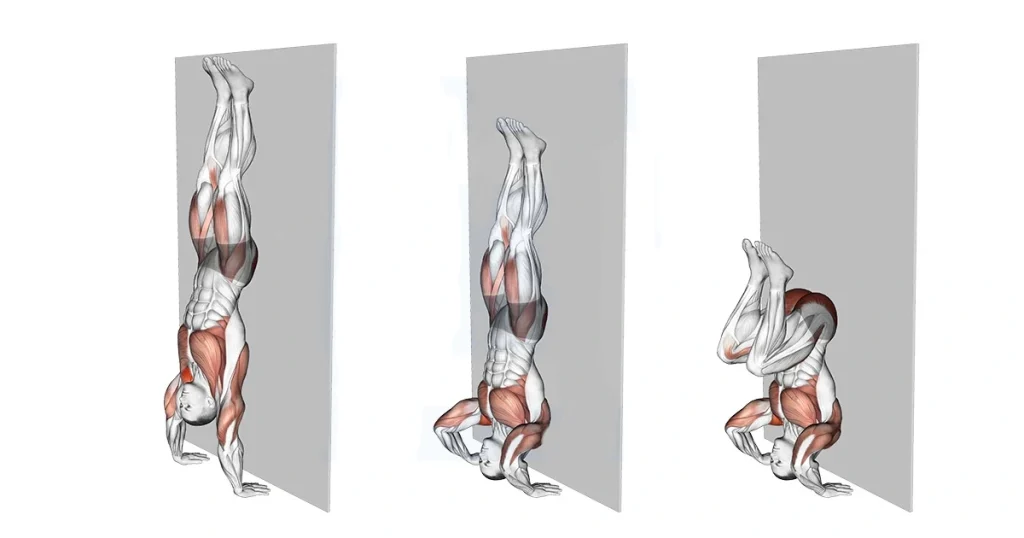
- How to Do It Right:
- Safely get into the top position: Kick up carefully into a handstand against a sturdy wall. Get your hands placed comfortably (often slightly wider than shoulder-width), body straight, heels gently touching the wall.
- Brace Everything: Core tight, glutes tight, shoulders actively PUSHING into the ground (packed!).
- The Slow Lower: Bend your elbows slowly and with total control, lowering the top of your head towards the floor. Aim for 3-5 seconds down. Fight gravity every inch! This is where the magic happens.
- The Bail: Once you reach your controlled depth (head lightly touches the floor or you feel strong tension), don’t try to push back up yet. Safely lower one foot, then the other, to the floor. Start with partial range negatives if needed!
Box Pike Push Ups
Similar to Pike Pushups but significantly easier. Elevating your hands reduces the load on your shoulders (delts, triceps) while still teaching the movement pattern and core engagement. Perfect if regular Pike Pushups are too challenging. You can gradually lower the height of the box as you get stronger.
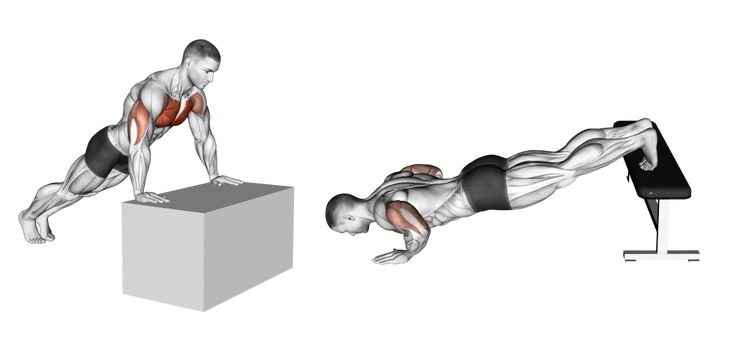
- How to Do It Right:
- Place your hands firmly on a sturdy box, bench, or step. The higher the box, the easier.
- Walk your feet back until your body forms a straight line from shoulders to hips (less severe angle than a full pike).
- Keep core braced, shoulders packed.
- Lower your head towards the box by bending your elbows (aiming between your hands).
- Push back up powerfully. Focus on feeling your shoulders work.
Wall Walks
This is fantastic for overall shoulder (deltoid) strength and stability, trap engagement, core control, and crucially, getting comfortable being upside down! It builds strength through a range of angles.
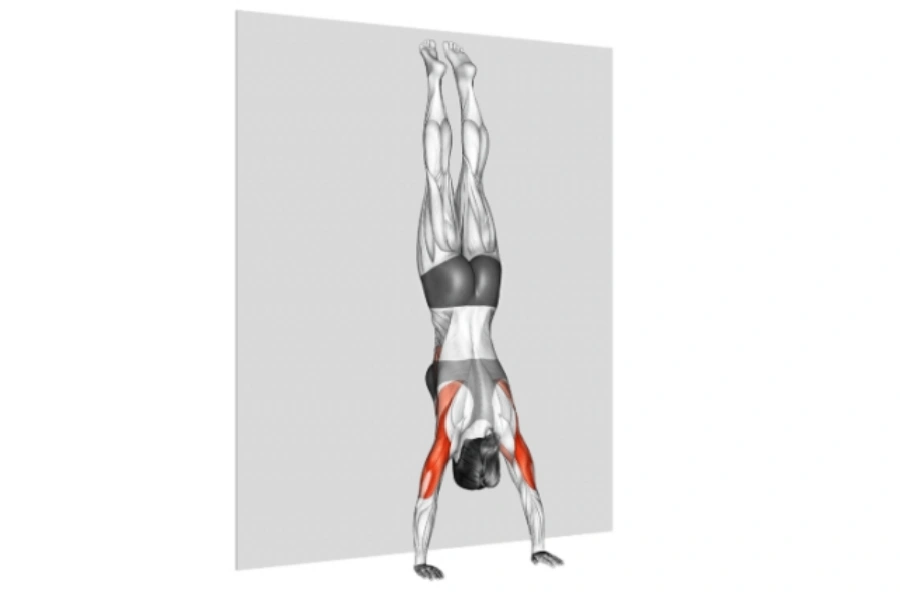
- How to Do It Right:
- Start in a high plank position with your feet against a wall.
- Walk your feet up the wall while simultaneously walking your hands backwards towards the wall. Keep core tight!
- Go as vertical as your strength and comfort allow – maybe just 45 degrees at first. Your goal is to get your chest close to the wall in a controlled manner.
- Hold the most vertical position you can comfortably manage for a second or two, actively pushing the floor away (engage shoulders!).
- Slowly and with control, walk your hands forward and feet down the wall back to the starting plank. Control the descent!
Handstand Holds and Kick-Ups
While primarily an isometric (static) hold, this builds essential shoulder stability (deltoids, traps), core strength, and body awareness in the inverted position. It teaches you to find balance and builds the confidence to be upside down without immediately pressing. Kick-Ups practice getting into position efficiently.
So much of the HSPU is mental! Just holding a handstand against the wall teaches you it’s okay to be upside down. Breathe!
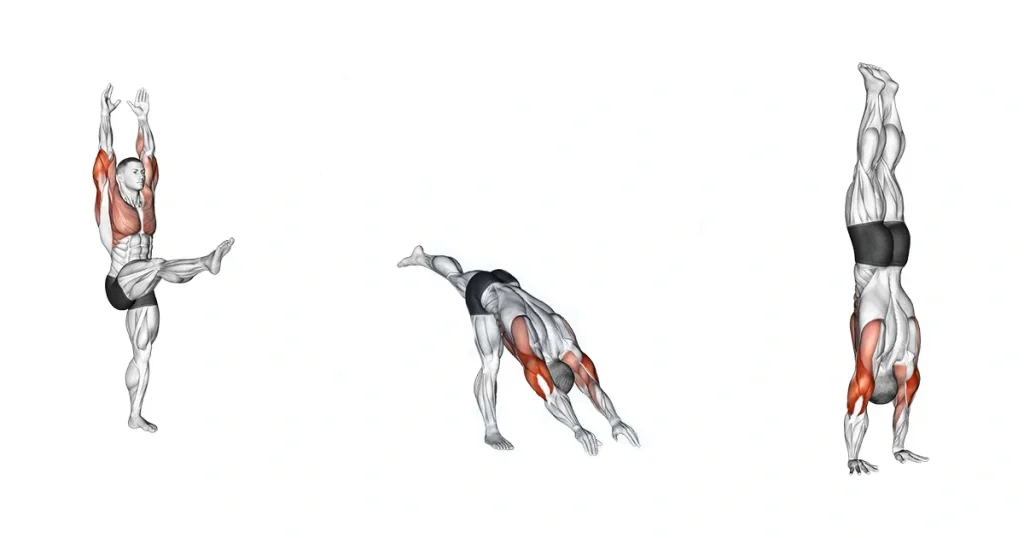
- How to Do It Right (Holds):
- Kick up carefully into a handstand against the wall.
- Focus on: Hands firmly planted (fingers spread!), shoulders actively pushing up and packed down (away from ears!), core braced tight, legs straight, heels gently touching the wall.
- Hold for time (start with 10-20 seconds). Focus on quality tension, not just hanging out.
- Lower safely with control.
- How to Do It Right (Kick-Ups):
- Practice the motion of kicking one leg up while using the other leg as a pendulum to find the wall. Start with short, controlled kicks.
- Focus on landing softly with both feet against the wall simultaneously. Avoid wild kicks! Consistency is key.
| Component | Purpose | Examples in Plan |
|---|---|---|
| Vertical Push | Builds HSPU strength | Z Press, Seated Press, Pike Push-Ups |
| Vertical Pull | Counters push, prevents imbalance | Lat Pulldowns, Inverted Rows |
| Legs (Knee-Dom) | Lower body strength foundation | Goblet Squats |
| Legs (Hip-Dom) | Posterior chain development | Dumbbell RDLs |
| Core Stability | Essential for inversion control | Planks, Dead Bugs |
| Inversion Skill | HSPU-specific practice | Wall Walks, Handstand Holds |
Remember my wobbly start? That’s where you are now. Stick with these foundational movements, celebrate the small wins (like finally nailing a full Pike Pushup or holding a solid 30-second handstand!), and trust the process. That first smooth, controlled handstand push-up against the wall? It’s coming. You’ve got this. Now go pick an exercise and get started – your future inverted self will thank you!
Welcome! I’m Jordan Mitchell, the dedicated editor at Leadman Fitness, where we specialize in manufacturing high-quality bumper plates, barbells, weight machines, kettlebells, and dumbbells. With a passion for fitness and a keen eye for detail, I ensure that our product information is clear, accurate, and engaging for our customers. My role involves collaborating closely with our design and production teams to highlight the innovative features and superior craftsmanship that set Leadman Fitness apart in the industry. Whether you’re a professional athlete or a fitness enthusiast, I’m here to provide you with the information you need to achieve your training goals with our top-of-the-line equipment.
